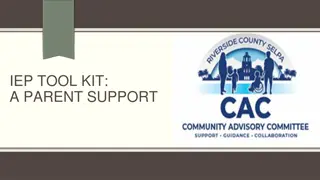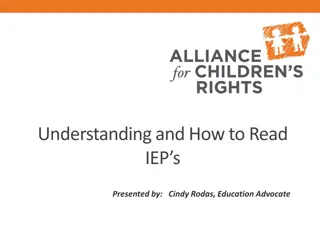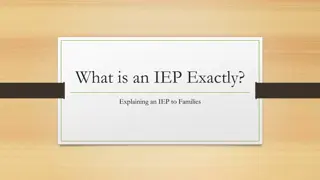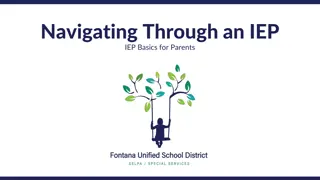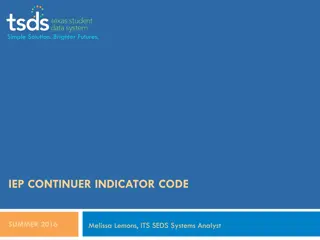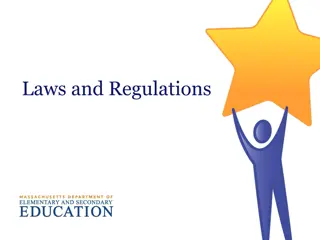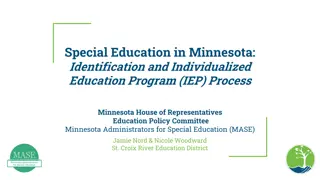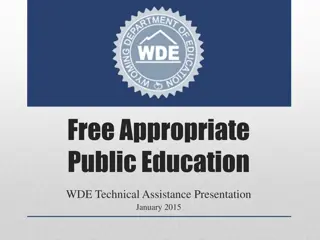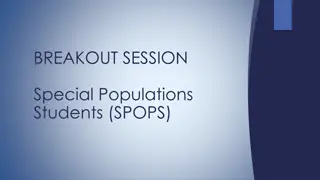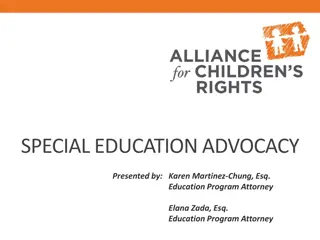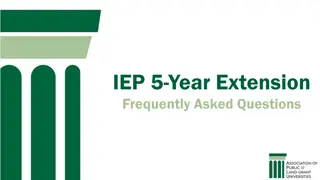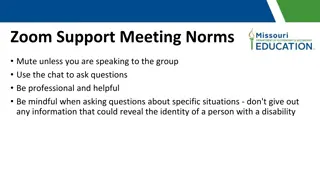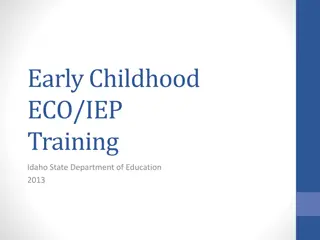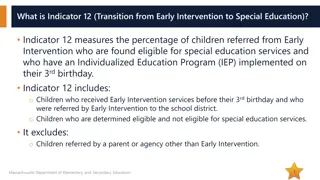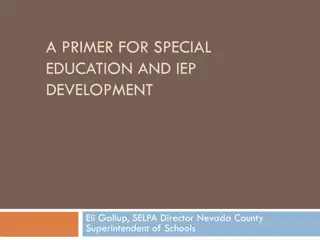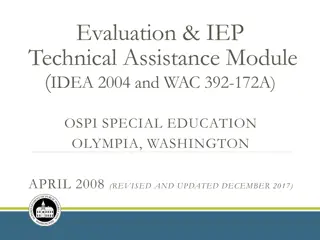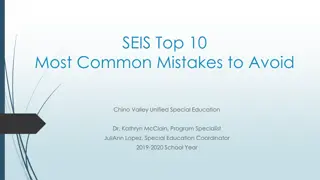Understanding Your Child's Individualized Education Plan (IEP) in Special Education
Fontana Special Education Local Plan Area (SELPA) is committed to providing quality educational services to students with exceptional needs. Learn about navigating IEP paperwork, the role of parental involvement, and communication strategies with the IEP team. Discover the significance of an IEP tailored to your child's unique learning requirements and get insights into the composition of the IEP team.
Download Presentation

Please find below an Image/Link to download the presentation.
The content on the website is provided AS IS for your information and personal use only. It may not be sold, licensed, or shared on other websites without obtaining consent from the author. Download presentation by click this link. If you encounter any issues during the download, it is possible that the publisher has removed the file from their server.
E N D
Presentation Transcript
CAC Parent Training Understanding Your Child s IEP
Fontana Special Education Local Plan Area (SELPA) The office of Special Services, Special Education Local Plan Area (SELPA), is dedicated to providing quality specially designed instructional support and services for students, ages 3 through 21, identified as requiring special education and related services. It is the policy of the Fontana Unified School District (FUSD) /SELPA that all children with disabilities residing within FUSD boundaries, regardless of the severity of their disability and who are in need of special education and related services, are identified, located, and evaluated. Special Services works collaboratively with the school sites, district departments, agencies and parents to provide the services required to meet the unique need of our students who are eligible for special education and related services.
Fontana SELPAs Mission The Mission of the Fontana Special Education Department is to provide equitable, inclusive, and quality education to students with exceptional needs by providing supports, services and resources to students, staff, parents, and the community to prepare students for success in college, career and life.
Agenda Navigating the Individualized Education Plan (IEP) Paperwork Importance of Parental Involvement Active Listening to Encourage Collaboration Productive Communication with the IEP Team
What is an Individualized Education Plan (IEP)? An IEP is an Individualized Education Plan for a student who is eligible for special education services. An IEP is meant to address a child s unique learning needs. It is a legally binding document outlining special education services.
Who are the IEP Team members? Parent General Education Teacher Administrator or Admin Designee Special Education Teacher or Designated Service Provider(s) Student (when appropriate and when discussing post- secondary transition) Other individuals with knowledge and/or expertise regarding the student Anyone who can interpret the instructional implications of the evaluation if an assessment was conducted.
When do we hold an IEP Meeting? Initial evaluation Plan Review/Review of Progress (held annually) Amendment Parent Request Eligibility Evaluation (held every three years) Manifestation Determination
Orthopedic Impairment Other Health Impairment 13 Eligibility Categories Specific Learning Disability Language and Speech Disorder When determining Eligibility Fontana uses the two-Pronged Approach to Eligibility. Traumatic Brain Injury Visual Impairment Autism Deaf/Blind First the student must meet State Eligibility Criteria Deafness Emotional Disturbance Hearing Impairment AND Intellectual Disability Second the student must require Special Education Services Multiple Disabilities
Understanding the Process Present Levels of Academic and Functional Performance (PLAFP) Evaluation Goals Services *Multiple measures of data including, but not limited to, formal/informal assessment, observations, stakeholder/parent input, and student work samples are utilized to assist in Establishing the Present levels of Academic and Functional Performance (PLAFP).
What is the Notice of Procedural Safeguards? An overview of educational rights and procedural safeguards Must be provided to you when: At each IEP meeting Initial referral for assessment Each time an assessment plan is presented Upon receipt of the first state or due process complaint in a school year Decisions that result in a change in placement You ask for a copy
Procedural Safeguards explained: Participation You have the right to participate in meetings about ELIGIBILITY, ASSESSMENT, or EDUCATIONAL PLACEMENT. You have the right to participate in the development of the IEP. You have the right to audiotape the proceedings with 24-hour prior notice. You have the right to discuss all program options and be given that information
Other Components of the Procedural Safeguards Surrogate Parent Appointment Nondiscriminatory Assessment Independent Educational Evaluation (IEE) Access to Educational Records
Procedural Safeguards: Where can you get help? Classroom teacher, case carriers, school psychologist School Site Administration Special Education Local Planning Area (SELPA) Office Parent Organizations California Parent Organizations - Quality Assurance Process (CA Dept of Education)
Notice of Meeting The notice of meeting will give you the logistics for your IEP meeting. What type of meeting it is. When it will be held. Where it will be held. Who will be in attendance. And who you can contact regarding questions. It also gives you the opportunity to let the team know if you are available, need to reschedule, are bringing someone with you, or need translation at the meeting.
Excusal Form The excusal form is where the Team documents your consent for IEP mandated team members to be excused in whole or in part from an IEP meeting.
Information/ Eligibility The information and eligibility page is where identifying information about your student is documented. Name, D.O.B., Dates for current and future meetings, Meeting Type, age, grade, EL status, ID #, Parent/Guardian contact information, District and Residence School, as well as Ethnicity and Race. Eligibility is also documented on this page of the IEP as well as information pertaining to initial placement. Primary and/or secondary category student qualifies under. If a student is not eligible or being exited.
Present Levels of Academic and Functional Performance The present levels of performance page is where the team will document: Student strengths, preferences, and interests. Parent input and concerns to educational progress. Assessment data (state testing, English Language Development testing, Physical Education testing, and other assessments) as applicable. Hearing and vision screening. Student s present level of performance in the areas of: Academics, communication, gross/fine motor, social emotional/behavioral, vocational, adaptive/daily living skills, and health What areas goals will be written to address identified need.
Special Factors The special factors page is where the team documents assistive technology devices and/or services, low incidence services, equipment, and materials, and considerations if the student is blind, visually impaired, and/or deaf/hard of hearing. English Language supports are also outlined on this page. This page is also where the team will indicate behavioral concerns, supports, and if the team has/will develop a behavior goal and/or Behavior Intervention Plan.
Statewide Assessments The Statewide Assessment page is where it is indicated what Statewide assessment the student will participate in during that school year. Additionally, the accommodations for the specific assessments will also be indicated on this page. The Statewide Assessments in California are SBAC or CAA and for English Learners the ELPAC or Alternative ELPAC.
Individual Transition Plan The Individual Transition Plan (ITP) Page indicates activities to support students as they near post secondary life in the areas of career readiness, college readiness, and other transition services. It also documents if a student is diploma track bound or certificate of completion track bound. As well as tracking and updating credits earned and credits needed to graduate.
Annual Goals & Objectives The Annual Goals and Objectives pages will outline the area of need that the goal will address, the baseline (present level of performance) for that identified area of need, and the measurable goal to be targeted within the next IEP year. This page will also identify the State Standard the goal is addressing and who is responsible for supporting and reporting with implementation and progress reporting.
Behavior Intervention Plan The Behavior Intervention pages are included in the IEP when a student has behaviors that have been identified to impede the learning of themselves and others. The team will document the means of collecting data on the behavior, a definition of what the behavior looks like, and the frequency duration, and intensity of the behavior based on the data. This is where the team will document environmental factors considered, what the student is trying to communicate through the behavior, what strategies and structures the team will put in place to help the student gain access to what they are trying to communicate appropriately, and what the student's behavior looks like as it progresses and returns to baseline alongside how staff will respond to support.
Services and Educational Setting The Services and Educational Setting Page (Offer of FAPE) describes the service setting options considered during the IEP meeting, the possible harmful effects when accessing the special education environment, as well as any accommodations and modifications needed to access the educational setting. This page also outlines the services with the defined minutes and location as they will be delivered.
Parent Consent Consent to all parts of the IEP The IEP will be implemented within a reasonable amount of time Consent to some parts of the IEP Only portions of the IEP that the parent consented to will be implemented Decline the offer of initial special education services The IEP will not be implemented Not consent to the IEP The IEP will not be implemented, goals and services listed in the last consented IEP continue. A parent may revoke their consent to all special education services. This must be done in writing. The district will send prior written notice explain the school placement and that the student will no longer have protections under IDEA.
Notes Page The Notes Page is a summary of the discussions had during the IEP meeting. This is the district s document. The IEP team should notate parent concerns and requests on this page as well.
Communication What should be in my IEP Binder? Evaluation IEP Report Cards/ Progress Reports Work Samples Behavior Documentation
Other IEP information If your child is recommended for expulsion or is removed from school placement for over 10 days, the district must hold a Manifestation IEP to determine if the behavior was caused by the disability or a result of the district not providing services in the IEP A parent has the right to request an Independent Educational Evaluation (IEE) at public expense if they disagree with results of the district assessment. The district either grants the request based on policy or has to file for due process to support the district assessment. A parent may request to audio tape an IEP meeting. If this action is desired, a 24-hour notice is required All rights transfer to the student whey they reach the age of 18 unless they are conserved by the courts
Other IEP information A parent may request an IEP. Please put it in writing and the District will hold a meeting within 30 calendar days (with the exception of breaks consisting of more than 5 days) A parent may request copies of existing student records. The District will provide copies within 5 business days. Parents may request copies of draft IEP and assessment reports prior to the meeting. The District will provide draft copies if available. A child placed by parent in private school has the right to a service plan but not FAPE.
Positive Relationships Get Involved in Schools Based in respect, transparency, and trust Be present as often as you can Be intentional and reach out to the school Share with school team your desires, dreams, and hopes for your student Encourage all family members to come and support with school events Build Relationships Take Opportunities to Help with Events
Keep Asking Questions: Empower Families Tell me more about Encourage the engagement of other families to be involved with the school Why does this continue to happen Stay up to date with events at the school Get Site needs can change yearly What should I be asking involved in Parent Committees that I haven t asked about yet?
Data Based Goals and Outcomes Help tell the story behind the data Story behind the numbers, as a parent you can add your voice to the story Participate in Surveys to help implement change Participate in surveys, the results from parent input can implement change Use data from surveys to guide improvement Families have a meaningful role in setting engagement goals
Develop Trusting Connections Collaborative Problem Solving Parents and school staff work together to meet student needs Teachers cannot do it alone. We need parents so we can learn who your child is. You know your child best. Teachers need to know your children, so they are fully supported in the classroom. Share Information Work Toward a Shared Goal This person can help support you and may be able to achieve more student success through a collaborative effort Life events can impact student performance Collaboration with family and parents creates an honest dialogue Communicating with teacher, team can develop an action plan to solve instructional needs Team can focus on student success as the primary goal
Multi- Dimensional Communications Get Involved & Advocate More Support = More Involvement Face-to- Face Establishes a relationship Allows for increased follow up communications Call Email Teams meetings Tier 2 & Tier 3 levels of support tends to need more parental involvement Collaborate with teachers, school counselors, etc. May need to attend meetings to progress monitor student growth Use different methods to communicate as needed Shows your child school and relationships are important Methods of communication may vary based on family need
Active Listening to Encourage Collaboration
Active Listening You cannot truly listen to anyone and do anything else at the same time. M. Scott Peck, author of The Road Less Traveled
Why Active Listening Works Active listening is a way of listening that involves full attention to what is being said for the primary purpose of understanding the speaker. It is an important skill set for many different circumstances, from personal to professional. If we are not listening actively, we are likely to miss the real message.
Active Listening When someone is conveying a message, there are two meanings to gather: the content and the feeling or attitude underlying the message. An active listener is not only tuned in to the information conveyed, but also how it is conveyed and any nonverbal cues present. Listen for Total Meaning Respond to Feelings After listening, when a response is appropriate, the listener should respond to the feeling of what was said. In this way, the speaker feels understood and empathy is established. Nonverbal cues include tone of voice, facial or body expressions, and speed of speech. All of these taken together can convey a much deeper meaning than merely the content of what was said. Note all Cues
Examples: Signs of Active Listening Body Language Building Trust and Rapport Tone of Voice Asking Open- Ended Questions Verbal Affirmations Shows Interest in Group Discussion
Techniques for Active Listening Technique Paraphrasing Purpose Convey interest Encourage the speaker to keep talking To Achieve It Restate the information just received with your own words Reflect the speaker s basic feeling and emotions in words Examples You showed up at the meeting on time. Verbalizing Emotions Show that you understand Help the speak to evaluate their own feelings And this made you really angry.
Techniques for Active Listening Technique Asking Purpose Get More information To Achieve It Ask questions Examples And after that, John did not react? These seem to be the key ideas you ve expressed. Summarizing Review progress Pull together important ideas Establish a basis for further discussion Restate major ideas expressed, including feelings
Techniques for Active Listening Technique Clarifying Purpose Clarify what is said Help the speaker see other points of view To Achieve It Ask questions for vague statements Restate wrong interpretations to force further explanation Examples You said that you reacted immediately. Was this still on the same day? Encouraging Convey interest Encourage the speaker to keep talking Disagree Use varying intonations Offer ideas and suggestions Then the student approached you. How did he behave?
Productive Communication with the IEP Team
IEP Team Communication Put Stay Stay everything in writing Professional focused on the child
Which IEP Team Member Should You Contact? Case Manager The case manager is the Education Specialist that is assigned to your student. This person will communicate to all service providers, other teachers, administration, and with the family Site Administration Next steps when more support is required, contact the site administration SELPA Office Parental Rights and Procedural Safeguards Address concerns and Facilitate Resolution State Level California Department of Education complaint or Due Process Filing.
How are Disputes Resolved? Alternative Dispute Resolution Mediation Due Process Hearings
The "How" of Effective IEP Communication IEP is the Focus Stick to the Facts Stay Child Focused Important Concerns Transparency Stick to the facts, not emotions Pertinent Information to inform with team members: medical diagnosis, medications, unusual behaviors, and/ or educational rights For important concerns, use the IEP process Keep focused on what your child is or isn t doing Evaluations, progress, strategies, etc. Do not assume intent Request evaluations formally in writing Focus on what happened and how it affected your child
The Where of IEP Communication Stay professional and respect boundaries. Use designated meetings or office hours. If you see teacher out in public, discourage discussing school matters outside of school. Keep a designated home/school communication log via email with teacher or binder. Parents have access to student information via Parent Square. Social media is not a place to discuss your student s IEP or frustrations with the team. Communicate with the team at school.


